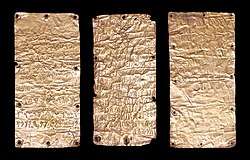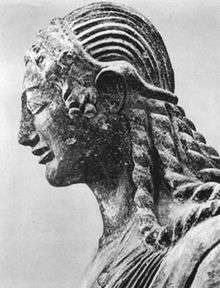Pyrgi Tablets
The Pyrgi Tablets, found in a 1964 excavation of a sanctuary of ancient Pyrgi on the Tyrrhenian coast of Italy (today the town of Santa Severa), are three golden leaves that record a dedication made around 500 BC by Thefarie Velianas, king of Caere, to the Phoenician goddess ʻAštart. Pyrgi was the port of the southern Etruscan town of Caere. Two of the tablets are inscribed in the Etruscan language, the third in Phoenician.[1]

The writings are important in providing both a bilingual text that allows researchers to use knowledge of Phoenician to interpret Etruscan, and evidence of Phoenician or Punic influence in the Western Mediterranean. They may relate to Polybius's report (Hist. 3,22) of an ancient and almost unintelligible treaty between the Romans and the Carthaginians, which he dated to the consulships of Lucius Junius Brutus and Lucius Tarquinius Collatinus (509 BC).
The tablets are now held at the National Etruscan Museum, Villa Giulia, Rome.
Phoenician text
The inscriptions are known as KAI 277; they read:
- lrbt lʻštrt,
- To lady Ashtarot,
- ʼšr qdš ʼz, ʼš pʻl, wʼš ytn tbryʼ wlnš mlk ʻl kyšryʼ.
- This is the holy place, which was made, and which was given by Tiberius Velianas who reigns over the Caerites.
- byrḥ zbḥ šmš, bmtnʼ bbt, wbn tw.
- During the month of the sacrifice to the Sun, as a gift in the temple, he built an aedicula.
- kʻštrt ʼrš bdy lmlky šnt šlš, byrḥ krr, bym qbr ʼlm
- For Ashtarot raised him with Her hand to reign for three years from the month of Churvar, from the day of the burial of the divinity [onward].
- wšnt lmʼš ʼlm bbty šnt km h kkb m ʼl.
- And the years of the statue of the divinity in the temple [shall be] as many years as the stars above.[2]
The Phoenician text has long been known to be in a Semitic, more specifically Canaanite language (very closely related to Hebrew, and also relatively close to Aramaic and Ugaritic); hence there was no need for it to be "deciphered." And while the inscription can certainly be read, certain passages are philologically uncertain on account of perceived complications of syntax and the vocabulary employed in the inscription, and as such they have become the source of debate among both Semiticists and Classicists.[3]
Supplementary to the Pyrgi Tablets are inscriptions on vessels found in the sanctuary at Pyrgi:
- unial: div) patera, or plate V TLE 877
- unial:(div) patera, or plate V REE 40 n54
- ]starte/s/ ?] cve[r (]starte/ / in REE) (div?)
- fragment vasis, or vessel IV REE 56 n31
- mi :"s'uris : cava'th'as,(div)patera, or plate V REE 64 n36.
- ]xcava'th'as 2]a emini[(div) Greek kylix, V REE 56 n24[4]
Phoenician vocabulary
- ʼlm, divinity [Semitic *ʼil- "god"]
- ʼrš, to raise
- ʼš, which, who, that [rel.pron]
- ʼšr, place
- ʼz, this [ ha-dha? ]
- ʻl, over, above [Semitic *ʻal-]
- ʻštrt, Astarte [Semitic *ʻaṯtar-]
- b-, in, at, with, on [Semitic *bi-]
- bt, house, temple [Semitic *bayt-]
- kkb, star [Semitic *kabkab-] [hakkawkabīm/hakkawkabūm = the-stars]
- k-, for, since [Semitic *ki-]
- km, like, as [ka-ma]
- krr, Churvar [calendar month] [cf. Etruscan Χurvar]
- kyšryʼ, Caerites [a people]
- l-, to, for [Semitic *la-]
- lmʼš, statue
- mlk, to rule, to reign [Semitic *mlk]
- mtnʼ, gift [Semitic *ntn 'to give']
- pʻl, to make, to do [Semitic *pʻl]
- qbr, burial
- qdš, holy
- rbt, lady [cf. Akkadian rābu "grand, large"] [rabbu, female: rabbatu ]
- šlš, three [Semitic *ṯalāṯ-]
- šmš, sun [Semitic *šamš-[5]]
- šnt, year [šanot "years" – from: šanāt]
- tw, aedicula [taw]
- w-, and [Semitic *wa-]
- bn, to build [ bny ] [wayyiben = [and] he built]
- yd, hand
- ym, day [Semitic *yawm-]
- yrḥ, month [Semitic *warḥu-] [Canaanite: yarhu]
- ytn, to give [Semitic *[y]-ntn] [ya-ntin[u]] he-gives / Hebrew: yittēn
- zbḥ, sacrifice
Etruscan text
- First plate:
ita tmia icac he rama sva va ti eche unial astres themia sa mech thuta thefa rpie velianas sal cluvenias turu ce munistas thuvas tameresce ilacve tulerase nac ci avi l chur var tesiameitale ilacve alšase. nac atranes zilac al seleitala asnasv ers itanim heram ve avil eniaca pulumchva.
- First plate:
- Ita tmia icac heramašva vatieχe Unial-Astres, θemiasa meχ θuta.
- This temple and these Hermes idols are dedicated to Uni-Astre, built by the clanspeople.
- Θefariei Velianas sal cluvenias turuce.
- Tiberius Velianas the pleasing aedicula has given.
- Munistas θuvas tameresca ilacve tulerase.
- That burial of his own by these priests with idols was encircled.
- Nac ci avil χurvar, tešiameitale, ilacve alšase.
- For three years [in the month of] Churvar, with Her burnt offerings, with idols [it was] buried.
- Nac atranes zilacal, seleitala acnašvers.
- During the reign of the chief, in Her hand [he] would be brought forth (ie: Uni-Astre gave him authority to rule).
- Itanim heramve, avil eniaca pulumχva.
- And with these Hermes idols, the year(s) shall endure as the stars.
- Second plate:
- Nac Θefarie Veliiunas θamuce cleva etunal Masan tiur, Unias šelace.
- When Tiberius Velianas had built the statue of the sanctuary [in] the month of Masan, Uni was pleased.
- Vacal tmial avilχval amuce pulumχva snuiaφ.
- The votives of the temple yearly have been as numerous as the stars.
Etruscan vocabulary
- *acna(s), to bring forth (⟨acnaš-ver-s⟩ '[he] would be brought forth')
- [perhaps -⟨u⟩, passive + -⟨er⟩-, purposive, common in the LLZ, had combined to form a passive optative in -⟨ver⟩- 'would be']
- Note ⟨huśur maχ acnanas, arce.⟩ "Having brought forth (ie: given birth to) five children, [she] raised [them]" (TLE 887)
- *alš, to bury (⟨alš-as-e⟩ 'buried')
- *am, to be (⟨am-uc-e⟩ 'has been, had been')
- ⟨an zilaθ amce mecl Rasnal.⟩ "He had been a chief of the Etruscan people." (ET Ta 7.59)
- astre, Phoenician goddess of fertility, associated with Uni (⟨astre-s⟩ 'of Astre') [Phoenician ⟨'štrt⟩ ← *'aṯtarṯ]
- *atran, reign, rulership
- avil, year (⟨avilχva-l⟩ 'of the years, yearly')
- ca, this (⟨ca⟩ 'this', ⟨ica-c⟩ 'and this')
- ci, three
- *cluvenia, aedicula (⟨cluvenia-s⟩ 'of the aedicula')
- xurvar, month [Phoenician ⟨krr⟩ *kurar]
- *en, to last, endure (⟨en-iac-a⟩ 'shall endure')
- ⟨śacnicleri cilθl, śpureri, meθlumeric, enaś.⟩ "By way of these sacred objects of the sanctuary, by the city and by the people, [it] endures" (LLZ, col 9, lines 12-13)
- *etan, sanctuary (⟨etan-al⟩ 'of the sanctuary')
- *heram(aš), Hermes idol (⟨heramv-e⟩ 'with the Hermes idols', ⟨heramašva⟩ 'Hermes idols')
- *ila, idol (*ilacva 'idols', ⟨ilacv-e⟩ 'with idols')
- meχ, people
- muni, burial, plot of land (⟨muni-s⟩ 'of the burial')
- nac, when, during, while
- *pulum, star (⟨pulum-χva⟩ 'stars', ⟨pulun-za⟩ 'little star')
- ⟨fulumχva⟩ (Cippus perusinus, lateral, lines 29-30)
- ⟨…pulunza ipal sacnina tinia tei aθemeiś caś…⟩ "…the little star for which the sacred Tinia of the sky…" (CIE 6310)
- sal, pleasing
- *sel, hand (⟨sel-ei⟩ 'with the hand')
- *snuia, many (⟨snuia-φ⟩ "as many")
- ⟨śnuiu-φ⟩ "as many" (LLZ, col 6, lines 1,2,4)
- *šel, to please (⟨šel-ac-e⟩ 'has pleased') [cf. ⟨sal⟩]
- ta, that (⟨ita⟩ 'that', ⟨⟩ 'and with that', ⟨ta-s⟩ 'of that', ⟨tala⟩ 'her', ⟨tal-e⟩ 'with her')
- tešiam, burnt offerings (⟨tešiam-ei⟩ 'with burnt offerings')
- ⟨Śucic firin tesim.⟩ "And incense was burned as a burnt offering" (LLZ, col 7, lines 9-10)
- tmia, temple (⟨tmia-l⟩ 'of the temple')
- *tuler, to encircle (⟨tuler-as-e⟩ 'encircled') [cf. ⟨tul⟩ 'border, boundary']
- tur, to give (⟨tur-uc-e⟩ 'has given')
- *θem, to build (⟨θem-iasa⟩ 'built', ⟨θam-uc-e⟩ 'has built')
- θefariei, Tiberius [Roman male name]
- θuta, clan, nation
- θuva, oneself, (⟨θuva-s⟩ 'one's own') [cf. ⟨θu⟩ 'one, single']
- ⟨θuker akil tuś thuveś.⟩ "Thuker completed his own tomb." (TLE 672)
- uni, Etruscan mother goddess of fertility (⟨uni-al⟩ 'of Uni') [cf. Latin Iūno]
- vacal, votive offering
- ⟨celi suθ vacl θesnin⟩ "Upon the earth of the tomb a votive offering was dedicated." (LLZ, col 5, lines 15-16)
- *vat, to dedicate (⟨vat-ieχ-e⟩ 'to be dedicated')
- velianas, Velianas [family name].
- zilaχ, chief (⟨zilac-al⟩ 'of the chief')
- ⟨svalasi, zilaχnuce.⟩ "[While] living, [he] had been chief." (TLE 173)
- ⟨zilaχnce avil xi.⟩ "[He] had been chief eleven years." (REE 40, n75)
- *acna(s), to bring forth (⟨acnaš-ver-s⟩ '[he] would be brought forth')
Notes
- The specific dialect has been called "Mediterranean Phoenician" by Schmitz, Philip C. (1995). "The Phoenician Text from the Etruscan Sanctuary at Pyrgi". Journal of the American Oriental Society. JSTOR. 115 (4): 559-575. doi:10.2307/604727. ISSN 0003-0279. JSTOR 604727. Full bibliography of Pyrgi and the tablets
- Transcription from Hildegard Temporini, Joseph Vogt, Wolfgang Haase. 1972. Aufsteig und Niedergang der Römischen Welt, vol. 2, part 25. P.201. Also, along with the original Phoenician letters, in Haarmann, Harald. 1996. Early Civilization and Literacy in Europe: An Inquiry into Cultural Continuity in the Mediterranean World. P.355
- For the most recent analysis of the inscription and summary of the various scholarly interpretations, see Schmitz, P. 1995 "The Phoenician Text from the Etruscan Sanctuary at Pyrgi." Journal of the American Oriental Society 15:559-575.
- Source for the Pyrgi inscriptions :"Iscrizioni Etrusche". Archived from the original on 2010-09-23. Retrieved 2012-02-26.
- The Patterning of Root Morphemes in Semitic. 1990. In: On language: selected writings of Joseph H. Greenberg. Ed. Keith M. Denning and Suzanne Kemmer. P.379
References
- Massimo Pittau (1996): "Gli Etruschi e Cartagine: i documenti epigrafici". L'Africa romana: atti dell'11. Convegno di studio, 15-18 dicembre 1994, Cartagine, Tunisia. Sassari, Editrice Il torchietto. V. 3, p. 1657-1674.
External links
| Wikimedia Commons has media related to Pyrgi Tablets. |
- The Etruscan Texts Project A searchable database of Etruscan texts.
- Photograph, transliteration, and partial translation
- Tavola di Cortona e Lamine di Pyrgi - traduzione (Italian translation by Giovanni Semerano)
